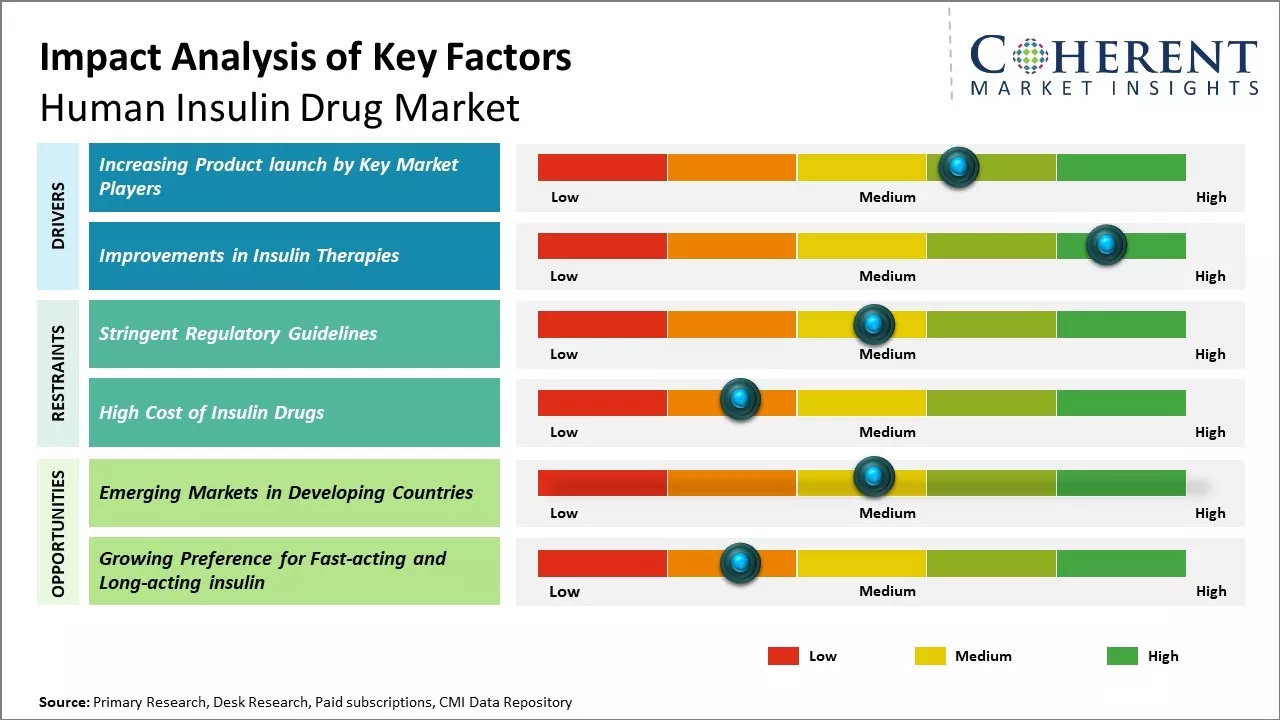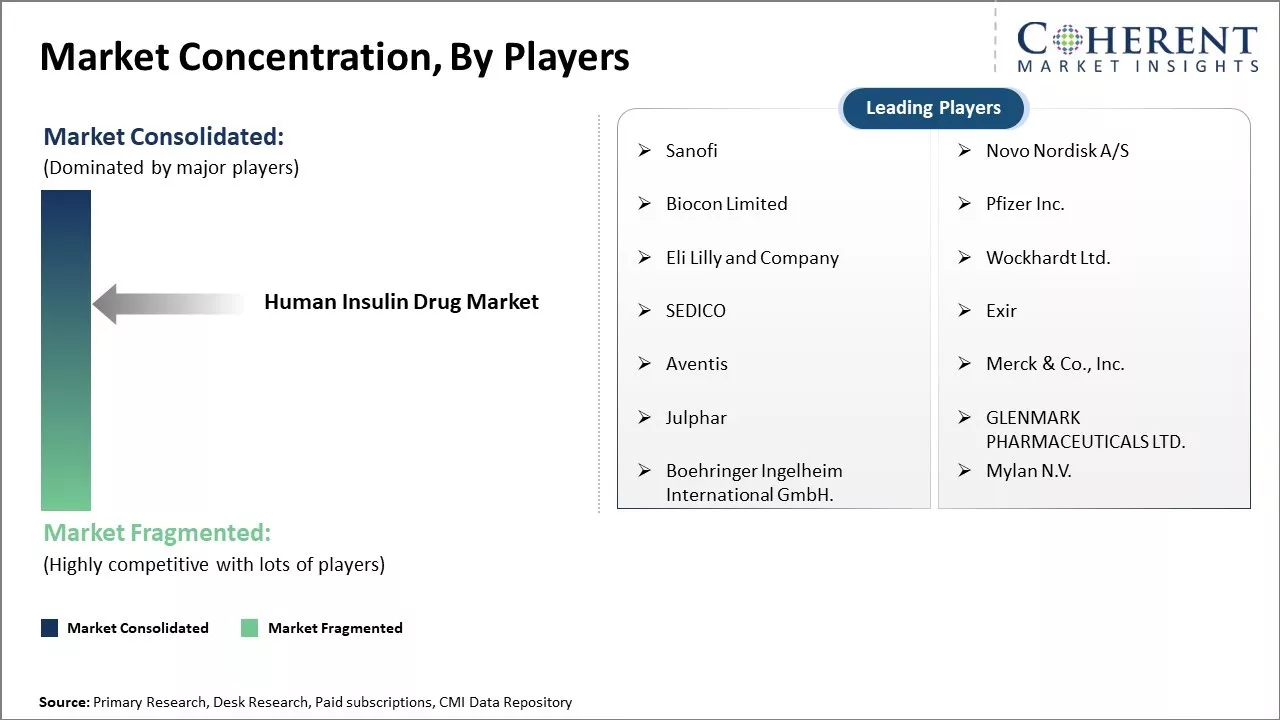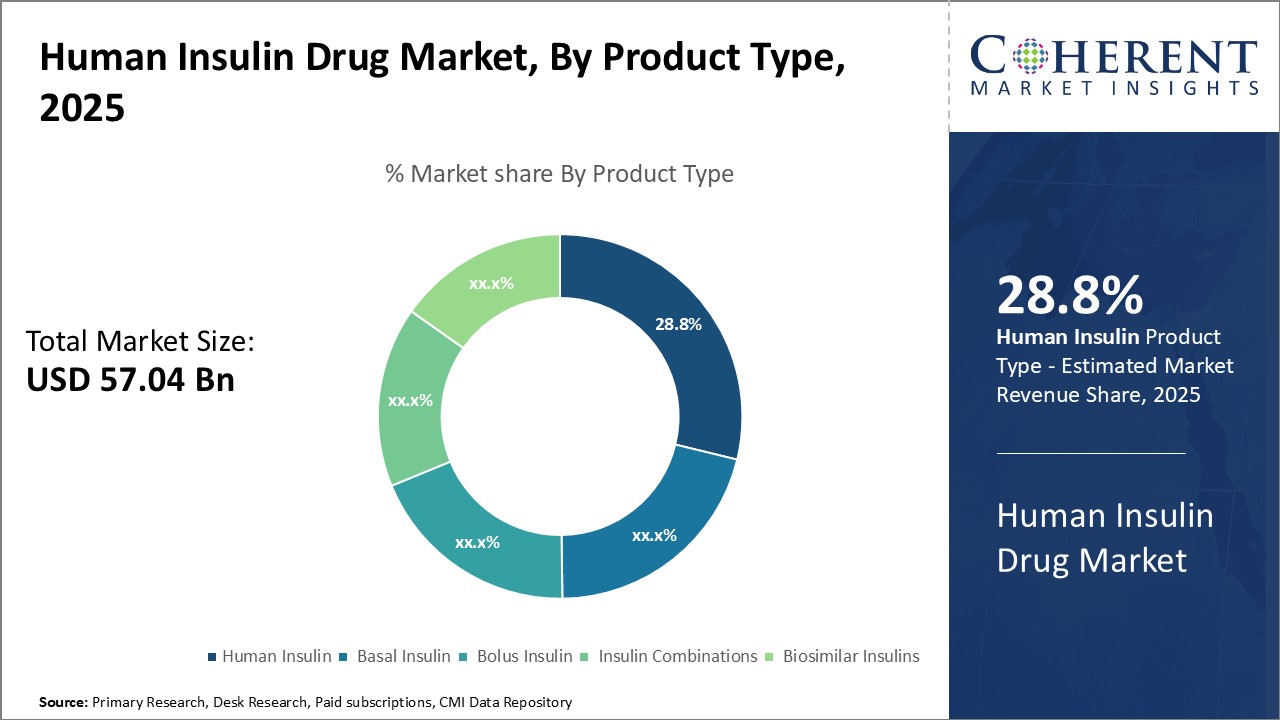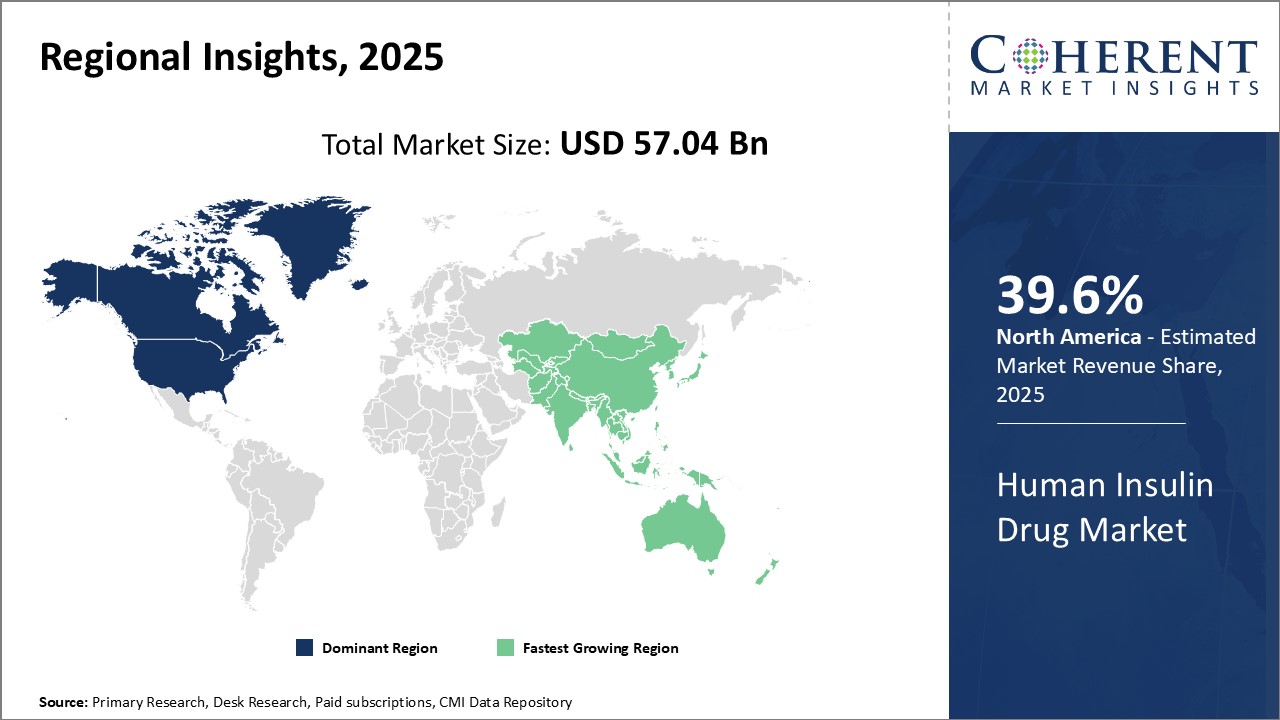Global human insulin drug market is estimated to be valued at USD 57.04 Bn in 2025 and is expected to reach USD 102.35 Bn by 2032, exhibiting a compound annual growth rate (CAGR) of 8.7% from 2025 to 2032.

Discover market dynamics shaping the industry: Download Free Sample
Rising health awareness among people and growing prevalence of diabetes globally are anticipated to increase the uptake of insulin drugs. According to the International Diabetes Federation, more than 537 million adults lived with diabetes in 2021 globally and this number is projected to rise to over 700 million by 2045. Increasing research investments by key players for development of superior drug forms such as long-acting insulin and wearable insulin devices can also drive the market growth. However, high costs associated with insulin therapies may limit market expansion.
Market Driver – Increasing Product launch by Key Market Players
Increasing product launches by key market players is expected to drive the market growth over the forecast period. For instance, in September 2022, Novo Nordisk A/S, a pharmaceutical company, launched unbranded biologic of Tresiba analog insulin to expand affordability options for patients. Tresiba (insulin degludec) injection, a once-daily long-acting basal insulin is indicated to control high blood sugar in patients 1 year of age and older with diabetes.

Get actionable strategies to beat competition: Download Free Sample
Improvements in Insulin TherapiesAdvancements like the introduction of long-acting, rapid-acting and pre-mixed analogue insulin have provided physicians and patients with more flexibility and better options to manage blood glucose levels. Moreover, enhancements in insulin delivery systems like insulin pens and pumps delivering small and precise doses of insulin have led to improved outcomes. The evolution of insulin combinations and newer therapeutic regimens are helping to reduce complications through improved glycemic control. According to market experts, continued innovation in insulin therapies with new developments like inhaled insulins and smart insulin patches in the product pipeline are likely to attract more patients towards insulin use and boost growth of the human insulin market in the near future.
Key Takeaways from Analyst
Global human insulin drug market is expected to witness steady growth over the forecast period due to rising prevalence of diabetes worldwide. Growing geriatric population who are more prone to developing diabetes can boost sales of these drug However, stringent regulations pertaining to the approval of new drugs may hamper the market growth.
North America currently dominates the market owing to rapid adoption of advanced technologies for disease treatment. Asia Pacific is poised to be fastest growing region in the human insulin drug market due to improving access to healthcare in developing countries and growing medical tourism industry in the region.
With rising healthcare spending and increasing collaboration between market players and research institutes to develop more effective and affordable drugs, there has been huge demand for human insulin. The market provides opportunities for manufacturers to strengthen their positions by expanding product portfolios through mergers, acquisitions, and partnerships.
Market Challenges: Stringent Regulatory Guidelines
Stringent regulatory guidelines for product approval imposed by various health regulatory authorities across the globe are posing significant challenges for the growth of global human insulin market. The approval process for new insulin therapies and products has become increasingly complex over the years. Regulators are demanding extensive clinical trial data spanning many phases to establish safety and efficacy of insulin products before granting marketing authorization.
Market Opportunities: Growing Preference for Fast-acting and Long-acting Insulin
The growing preference for short acting and long acting insulin across the globe indicates a promising opportunity for the human insulin market. As modern lifestyles become increasingly fast-paced and complex, more individuals with diabetes are seeking insulin variants that allow for higher flexibility and discretion with medication administration. Short acting insulin analogues that can be taken immediately before a meal have seen rising demand. Their quick absorption profile permits tailored insulin delivery around unpredictable daily schedules. Similarly, long acting basal insulin extending over 12-24 hours is preferable to twice-daily injections for its round-the-clock stability and minimized risks of hyper/hypoglycemia during sleep. As diabetic populations continue to age and life expectancies lengthen in many countries, durable control of basal blood glucose becomes a higher priority, driving shifts towards long acting insulin formulations.

Discover high revenue pocket segments and roadmap to it: Download Free Sample
Insights, By Product Type: Affordability boosts adoption of human insulinProduct Type segment is sub-segmented into human insulin, basal insulin, bolus insulin, insulin combinations, and biosimilar insulins. Human Insulin sub-segment is estimated to hold 28.8% of the market share in 2025, owing to its affordability as compared to other insulin products. As it is extracted from animal sources like pig or cattle pancreas, the manufacturing process of human insulin is relatively simple and economical. This allows the production of human insulin at lower costs as compared to biosimilar or recombinant insulins. The affordability enables greater accessibility of human insulin to diabetic patients globally. It can meet the insulin needs of a large proportion of diabetic population who have price constraints. The lower cost of human insulin as compared to newer insulin types encourages higher compliance to insulin therapy especially in developing nations. This contributes to the higher adoption rate and market share of human insulin in the global human insulin drug market.
Insights, By Type: Convenience drives preference for short acting insulins
Type segment is sub-segmented into short acting and long acting. Short Acting sub-segment is estimated to hold 56.7% of the market share in 2025, owing to its convenience in administration. Short acting insulins have a relatively faster onset of action within 15-30 minutes and shorter duration of action up to 5 hours. This allows convenient pre-meal administration and better coverage of postprandial blood glucose levels. The short duration minimizes risk of hypoglycemia that may occur between meals or during the night. The convenient dosing frequency matches well with daily lifestyle and meal patterns. This eases insulin therapy management. The convenience and flexibility afforded by short acting insulins drive higher patient acceptability and clinical preference over long acting insulins. This boosts consumption of short acting insulins in the human insulin drug market.
Insights, By Application: Prevalence drives demand for Type 1 diabetes treatment
Application segment is sub-segmented into type 1 diabetes and type 2 diabetes. Type 1 Diabetes sub-segment is estimated to hold 61.7% of the market share in 2025, due to rising prevalence of type 1 diabetes globally. Type 1 diabetes results from autoimmune destruction of insulin-producing beta cells, making patients dependent on lifelong external insulin. It has lack of alternatives to insulin therapy unlike in Type 2 diabetes. The prevalence of type 1 diabetes is increasing at an alarming rate especially in children and adolescents. For instance, the incidence of type 1 diabetes in individuals under 20 years of age had increased by 70% between 2002 and 2012. The growing diabetes prevalence amid lack of alternatives to insulin therapy boosts demand for human insulin drugs targeted towards type 1 diabetes treatment.

Need a Different Region or Segment? Download Free Sample
North America is the dominant region in the global human insulin drug market and is estimated to hold 39.6% of the market share in 2025. The large size and high per capita healthcare spending of the U.S. has enabled North American pharmaceutical companies to invest heavily in R&D. The region is home to most of the major players in the insulin drug industry such as Novo Nordisk and Sanofi. The companies have used their size and financial might to gain significant market share globally through strategic acquisitions and partnerships in international markets. Most new insulin drug approvals and innovations are also led by North American firms, providing them a consistent competitive edge over rivals. This strong industry presence combined with a favorable regulatory environment and reimbursement policies has made North America the largest and most profitable market.
Asia Pacific has emerged as the fasting growing regional market for human insulin drug in recent years. Rapid economic development and rising living standards have boosted healthcare spending across Asia. Countries like China and India are particularly experiencing a growing disease burden of diabetes as obesity and sedentary lifestyles become more prevalent. Greater accessibility of diagnosis and treatment options is expanding the addressable patient population in the region. While production and pricing of insulin drugs are currently dominated by multinational companies, local manufacturers are also strengthening their capabilities. These cater to the large price-sensitive population through affordable biosimilar insulins. Asia Pacific market is witnessing increased investment and new product launches to tap its significant future growth potential.
Human Insulin Drug Market Report Coverage
| Report Coverage | Details | ||
|---|---|---|---|
| Base Year: | 2024 | Market Size in 2025: | USD 57.04 Bn |
| Historical Data for: | 2020 To 2024 | Forecast Period: | 2025 To 2032 |
| Forecast Period 2025 to 2032 CAGR: | 8.7% | 2032 Value Projection: | USD 102.35 Bn |
| Geographies covered: |
|
||
| Segments covered: |
|
||
| Companies covered: |
Sanofi, Novo Nordisk A/S, Biocon Limited, Pfizer Inc., Eli Lilly and Company, Wockhardt Ltd., SEDICO, Exir, Aventis, Merck & Co., Inc., Julphar, GLENMARK PHARMACEUTICALS LTD., Boehringer Ingelheim International GmbH., Mylan N.V. |
||
| Growth Drivers: |
|
||
| Restraints & Challenges: |
|
||
Uncover macros and micros vetted on 75+ parameters: Get instant access to report
*Definition: Global human insulin drug market consists of pharmaceutical drugs and therapeutics involving the hormone insulin used for diabetes treatment in humans. Insulin is essential for regulating blood sugar levels and is commonly administered via injection or infusion pumps. This market covers various insulin drugs that mimic the natural function of insulin in the body including rapid-acting, short-acting, intermediate-acting, long-acting, premixed, and new analog formulations of inhaled and oral insulin medications.
Share
Share
About Author
Vipul Patil is a dynamic management consultant with 6 years of dedicated experience in the pharmaceutical industry. Known for his analytical acumen and strategic insight, Vipul has successfully partnered with pharmaceutical companies to enhance operational efficiency, cross broader expansion, and navigate the complexities of distribution in markets with high revenue potential.
Missing comfort of reading report in your local language? Find your preferred language :
Transform your Strategy with Exclusive Trending Reports :
Frequently Asked Questions
Joining thousands of companies around the world committed to making the Excellent Business Solutions.
View All Our Clients